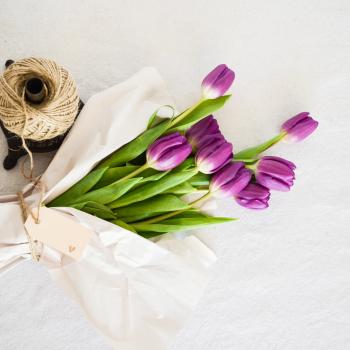
I recently ran into a good friend who’d been battling depression for years. She looked radiant. She smiled and said a therapist had healed her; he’d taught her to live wholly in the present, enjoy every flower she sees, block all but the here and now.
I’m glad this philosophy works for my friend, but it wouldn’t be helpful to me. I too believe in cherishing the present—both in time and place—but I couldn’t live without remembering the past or the beauty of distant things.
While every flower I encounter brings me instant joy, the past has taught me which ones smell delicious and which harbor poisons to avoid. And when there aren’t flowers anywhere in sight, I recall that all I need to do to find them is wait for springtime or travel somewhere else.
This is likely why I so enjoyed For the Time Being, a book by Annie Dillard that contemplates time and space. I love the way it assembles information: stories from China and Israel, the natural history of sand, wisdom from Confucianism, Christianity and Kabbalism, medical facts about birth and death.
I love the way it poses statistical questions: Do you remember what you were doing on April 30, 1991, when typhoon waves drowned more than 138,000 people in Bangladesh? Do you know the dead outnumber the living in the ratio of twenty to one?
I love the way it travels through the ages—from the days of the Chinese Emperor Qin, who unified his country in 221 BCE, to the days of the Galilean Rabbi Isaac Luria, who reinterpreted the Zohar in the 1500s, to the days of the French priest Pierre Teilhard de Chardin, whose archeological team discovered Peking Man in the 1920s, to the present day.
And I love the way For the Time Being juxtaposes incongruent images—images of clouds, carnage, waves, plagues, trains, cemeteries, dwarves—so that readers can stir them all together, add their own connections, and marvel at the subtle, complex stew.
What better way could there be to show that no matter our technologies or theories, we can’t control or comprehend our baffling world, or disentangle its disasters from its wonders? Dillard’s writing highlights that we humans, each unique and precious, are at once common and insignificant, and that this paradox unites us all.
This brings to mind a personal connection. While I believe in one God who made all that’s seen and hidden, I can’t believe that any single human doctrine can fully capture God’s utter mystery. All throughout the ages, and all around the world, his children have attempted to revere him in innumerable ways.
My tradition is Catholicism. The teachings, the liturgy, the organ, the incense, the light through stained glass: all of these move me to reverence. But you may be moved by something else. And the students I once taught at a yeshiva, by something different still.
What should we make of the difference? A few years ago, I signed up for a yoga class—something I’d never done before. Following the instructor’s directions, I sat cross-legged on the floor, straightened up my spine, pressed my palms together, relaxed my face, and closed my eyes.
The instructor began to chant in Sanskrit: Yogena chittasya padena vacham. The experienced students responded: Yogena chittasya padena vacham.
The instructor continued to chant: Malam sharirasya cha vaidyakena. Again the veterans responded: Malam sharirasya cha vaidyakena.
I couldn’t understand a single word. But despite this or likely because of it, I discerned something deeper than words could ever have disclosed. Sitting closed-eyed in that studio, I felt the presence of all of humankind—people calling, listening, responding, searching for each other and beyond.
And their dissonant separate voices—many raspy, off-key—combined oddly into harmony. It was a harmony that rose around me, ran through me, expanded within me.
It was a harmony distinct from all others, yet identical to all—the harmony of Gregorian chanting and Southern a cappella hymns, the harmony of Torah cantillations and Quranic tarteel.
It was all harmonies I’d ever heard and those I’d never imagined. It was all harmonies I’d yet to hear and those I never will.
In it, I sensed God.
I’ve remembered it often since then.
I remembered it when a Taliban assassin shot a Pakistani schoolgirl in the head, almost killing her, and when Hurricane Sandy swept the East Coast, killing dozens and leaving eight million without power.
I recalled it when a young gunman murdered twenty-six teachers and children in a Connecticut elementary school and when two brothers set off bombs at the Boston Marathon, wounding hundreds and leaving three dead.
I remembered it when Syrian government forces massacred five hundred civilians in a Damascus suburb and when a garment factory collapsed in Bangladesh killing and injuring three thousand workers.
Each time I’ve recalled that harmony, I’ve let it fuse with bygone melodies still resounding from the past and blend with distant songs I somehow knew were being sung in other places.
It’s always brought me peace; the peace I know is God.
So, for the time being, I’m determined to cherish that harmony, as I wish my good friend could. I hope to always keep it in my memory so that it can rise again to buoy me when the next typhoon waves come.
Jan Vallone is the author of Pieces of Someday, a memoir, which won the 2011 Reader Views Reviewers Choice Award. Her stories have appeared in The Seattle Times, Catholic Digest, Guideposts Magazine, English Journal, Chicken Soup for the Soul, Writing it Real, and Curriculum in Context. Once a lawyer at a large law firm, and later an English teacher at a tiny yeshiva high school, she now teaches writing and literature at Seattle Pacific University.










